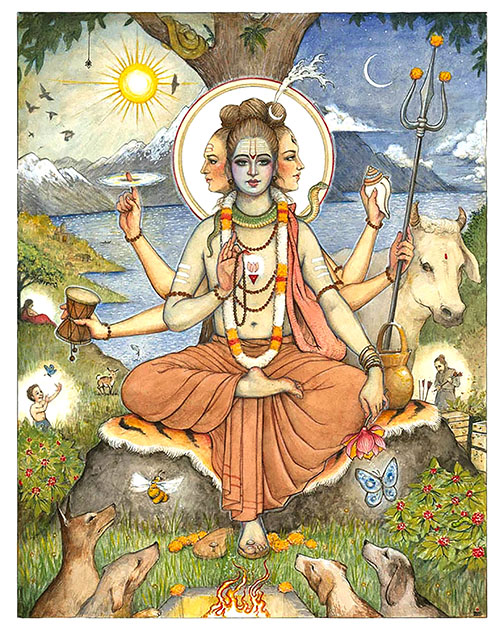
Watercolor painting on cotton fabric by Manohar Saini of Kishangarh. Available from ExoticIndiaArt.com
Sri Guru Gita is a compilation of verses dedicated to the veneration of the Guru—both one’s embodied Guru, as well as the Guru-tattva or Guru Principle. Many devotees repeat the entire Gita daily, though some repeat it yearly during the annual Guru Poornima (July full moon) celebration in order to attain the Grace of the Guru.
The origin of this sacred text is not fully known. It is a divine dialogue between Lord Siva and Goddess Parvathi at their abode on Mount Kailash, high in the Himalayas—in which they discuss the nature of Reality for devotees’ benefit. Parvati, surprised to see Siva prostrating to a Satguru, asks Siva to explain this devotion and His humility. Lord Siva explains that the Guru is a realized, enlightened soul and, in essence, Guru, God, and the inner Self of all are one. The Guru’s life is full of dedication and selfless service. It is the Guru who illuminates the spiritual path, removes the darkness, and teaches one how to know the Self.
Hareesh Christopher Wallis, PhD, Sanskrit scholar and Nondual Saiva Tantra expert, gives this overview of the history of the text:
“This text originated in Maharashtra, India. The Sri Guru Charitra (a text from around 1550 in Marathi language) contains, in its 49th chapter, the Sri Guru Gita in Sanskrit. Some scholars believe it was inserted in this text and is actually older, but its exact origins are largely unknown. It was most probably compiled from various sources by someone who gathered the “best” verses from various sources on the Guru. It was then added into Sri Guru Charitra because it has verses that go back to earlier texts.
“The verses were extracted from Saiva Tantra sources and mixed with elements of Bhakti Yoga and Vedanta. This is a kind of container into which the text is laid. That container is one in which we are told the seer, the meter, the mantra, and the visualization verse. The sage Suta is the bard of Sri Guru Gita and these teachings it contains come from oral transmission originally. Mantra Purusha practice (installing the 50 phenomes of Sanskrit in your body) and installing the Creator Deities in the chakras is suggested by the verse.

Sri Dattatreya, with his Gurus. Artwork by Erik Jacobsen.
“The connection of Sri Guru Gita to the Dattatreya lineage is very strong. Sri Dattatreya, is depicted as having three heads: Brahma, Vishnu and Siva. He is a composite deity of the Hindu tradition and considered to be the primordial Guru. He is said to have had Nature—in 24 aspects or forms—as his Guru.”
“Sri Guru Gita opens with a dhyana sloka or visualization verse that tells you how to meditate upon or visualize a specific deity. As Dr. Wallis explains: “The dhyana sloka is one that describes the Guru-tattva and not a physical Guru. It tells us how to meditate on the Guru-tattva, the principle of Guru. What is the Guru-tattva? That which brings you from darkness to light, including all your teachers and all that teaches you. In other words, whatever facilitates the spiritual process that moves us from the darkness of ignorance to light of wisdom is the Guru-tattva.”
The Dhyana Sloka:
Haṁsābhyāṁ parivṛtta-patra-kamalair divyair jagat-kāraṇair
viśvotkīrṇam aneka-deha-nilayaiḥ svacchandam ātmecchayā |
Tad-dyotaṁ pada-śāmbhavaṁ tu caraṇaṁ dīpāṅkura-grāhiṇaṁ
pratyakṣākṣara-vigrahaṁ guru-padaṁ dhyāyed vibhuṁ śāśvatam ||
Dr. Wallis translated the dhyana sloka below, followed by his commentary:
“One should meditate on the eternal all-pervasive state of the Guru, which is the embodiment of all the sacred sounds [of Sanskrit, the 50 sounds, the vibrational building blocks of the universe] in visible form. One should meditate on the [form of] practice and conduct which holds ‘the flame of the lamp,’ that is, the Śāmbhava state which illumines that spontaneous freedom (svacchanda) which is inscribed in everything in existence by the divine Causes of the World that have all bodies as their abode, and which are [installed within] the ‘lotuses’ (i.e. chakras) whose petals are rotated by ‘ham’ and saḥ.’ One should meditate on the Feet of the Guru.”
Commentary:
“Why should we meditate upon the Feet of the Guru? Because Anugraha, Grace, flows through the Feet. This sloka tells us that we should meditate on the state of the Guru. What is the state? It’s eternal and all-pervasive. We are not talking about a physical teacher, but the imperishable embodiment (pratyakṣākṣara-vigrahaṁ ) of the world/universe before our very eyes.
“The state of the Guru is the embodiment of all the phonemes (building blocks of reality itself) in visible form. One should meditate on the form of practice and conduct which holds the flame (the innermost self, atman) of the lamp (that which is the container for the essence-nature). This is pointing to our way of being in the world, which holds the flame of the lamp. Ask yourself: What form of practice and conduct leads to the Divine State? This state is the Śāmbhava state, the Divine state of Siva, the full awakeness that is the goal of the yogic path.”
Let us meditate on the activity of the Guru. Let us immerse fully in the teachings of the Guru because these hold the flame of the lamp that conveys the Śāmbhava state, the Divine state of radical freedom within every aspect of our very Being and existence. May the Grace of the Guru illuminate our paths. Jai Gurudev!

